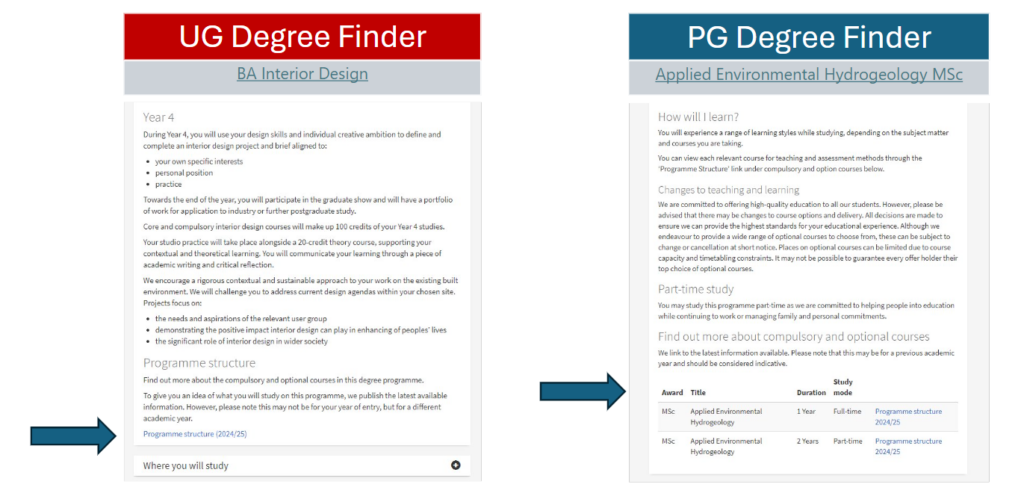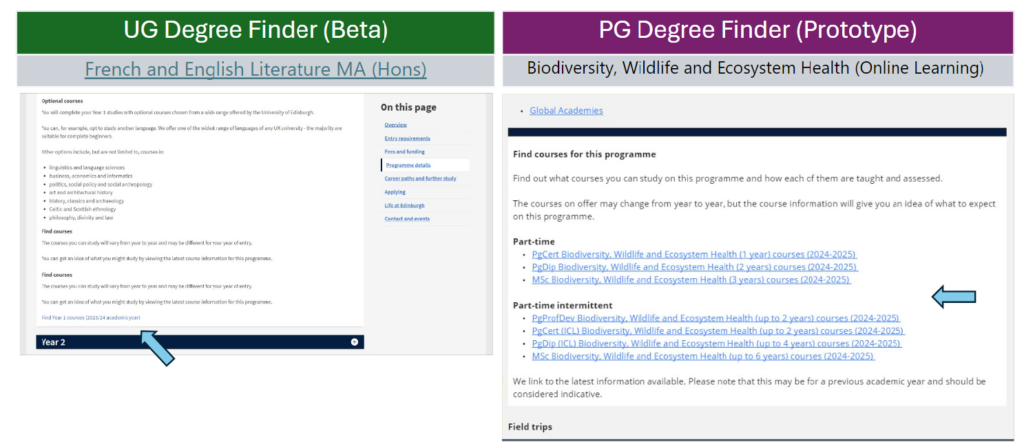Exploring how prospective students engage with detailed programme information
Is detailed programme information important to prospective students? Short answer: Yes. Long answer: Yes, and analytics and user research show us the marketing value of making this information accessible online.
Questions about the marketing value of detailed programme information
My work as a member of the Content Operations team has involved reviewing content for dozens of programme pages in the undergraduate and postgraduate degree finders in recent months. While reviewing the content, I was curious about the marketing value of providing detailed programme information on degree finder pages. I wanted to find answers to the following questions:
- Is detailed programme information important to prospective students?
- How (and when) do prospective students engage with detailed programme information?
- How will detailed programme information be presented in the future degree finders?
To answer these questions, I did some desk research and spoke to fellow team members and colleagues in other teams.
How is detailed programme information presented on a degree finder page?
In the current published versions of the degree finders, detailed programme information is included in the page content as a link to a different webpage which includes the relevant programme’s Degree Programme Table.

Examples of undergraduate and postgraduate degree finder programme pages, showing content sections where DPT links are included.
Degree Programme Tables (DPTs) are hosted on the University’s Degree Regulations and Programmes of Study (DRPS) website. They are the source of detailed information about the curriculum for each programme of study.
A programme’s DPT defines which courses are mandatory for a programme, and any prerequisites or co-requisites for optional courses.
Degree Programme Tables: What are they used for?
DPTs have different uses for different user groups across the University community.
Current students refer to a programme’s DPT:
- for information on their mandatory and optional courses,
- to keep track of the credits required for their programme’s outcome award
University staff members refer to a DPT:
- as the golden copy of information about a programme’s curriculum and course options
- for other administrative purposes such as course enrolment activities
Prospective students are the user group I’m focusing on. From my desk research and conversations with colleagues, I have gathered a lot of data and research findings to back up what we know about how prospective students use DPTs.
Insights from data analysis and user experience research
Links on postgraduate degree finder programme pages
Google Analytics data provides insights on how users engage with DPT links on the current Postgraduate degree finder‘s programme pages.

Graph showing the number of DPT link clicks per month from mid-December 2023 to mid-May 2024 across all postgrad degree finder programme pages.
DPT links get thousands of clicks per month. Peaks of more than 15,000 monthly clicks occur in the months of the year when prospective postgrad students are often most active in researching options.
Considering the volume of traffic to the postgraduate degree finder over this same period, the click-through rates for DPT links are relatively high. For example, on average, 7.2% of visitors to CSE (College of Science and Engineering) programme pages in the postgrad degree finder clicked on a DPT link during the period of mid-December to mid-May.
| College | CSE | CAHSS* | CMVM** |
|---|---|---|---|
| Average click-through rate for DPT links | 7.2% | 6.3% | 4.3% |
*CAHSS: College of Arts, Humanities and Social Sciences
**CMVM: College of Medicine and Vet Medicine
Links in emails to undergraduate applicants and offer holders
Colleagues in the Marketing and Digital Marketing teams shared details of how applicants and offer holders for CAHSS (College of Arts, Humanities and Social Sciences) undergraduate programmes engaged with DPT links included in conversion emails.
Campaign reports showed that DPT links in emails had high click–to–open rates, indicating that detailed programme information was of interest to many applicants and offer holders during the conversion period. Among recipients who opened these emails in 2024 and 2023, between 17% and 34% of them clicked on a link to view DPTs.
| Year | Link shared | Recipient group | Click to open rate |
|---|---|---|---|
| 2024 | Indicative DPTs | Applicants; offer holders | 17% |
| DPTs | Offer holders | 27% | |
| 2023 | Indicative DPTs | Applicants | 19% |
| Indicative DPTs | Offer holders | 34% | |
| DPTs | Offer holders | 28% |
User experience research: Top tasks and interview themes
I also looked for insights on prospective students’ engagement with DPTs from user experience research findings.
From card sorting exercises that have been carried out in recent years with research participants, “Detailed programme information” consistently comes up in the top 3 tasks for both undergrad and postgrad degree finder users, along with entry requirements and tuition fees.
In interviews that focused on experiences of using degree finder content, we learned why detailed programme information is important for users of the undergrad or postgrad degree finder:
- For undergraduate degree finder users, it tells students what the teaching and assessement experience will be like.
- Postgraduate degree finder users were more concerned with how course options and learning outcomes might benefit their employability as graduates.
| UG Theme: | What will my teaching and assessment experience be like? |
|---|---|
| UG Participant 1 | The course information… would really benefit people like me. It was a big factor in choosing Edinburgh. |
| UG Participant 2 | I’m surprised this [what you can study] information isn’t publicised as much… it’s a massive part of my degree. It’s a unique selling point. |
| PG Theme: | Will this programme’s course options benefit my career / lead to good employability outcomes? |
|---|---|
| PG Participant 1 | The most important thing for me is what you can study. The courses have to line up with what you want to do. |
| PG Participant 2 | The courses at each university was the main factor for me in deciding. I wanted to make sure each course was something I wanted to do. |
Detailed programme information was highlighted as a “unique selling point”; its availability was mentioned by both undergraduate and postgraduate participants as a key factor in choosing a programme at the University of Edinburgh.
Engagement with DPTs throughout the prospective student journey
These insights show us that prospective students engage with DPTs at multiple key points on the ‘prospective student to student’ journey, including:
- researching university options
- considering programme options
- applying to a programme
- decision-making as an applicant
- decision-making as an offer-holder
We can see that detailed programme information is important to prospective students when it is used at so many stages of the journey to becoming a current student.
Why are DPT links missing from some degree finder pages?
Data and research insights on how prospective students engage with DPTs highlight the marketing value of updating and publishing DPTs annually. With this in mind, it might be surprising to find that not all degree finder pages include a DPT link. On the postgraduate degree finder in particular, you might occasionally come across a programme page that does not have any DPT link(s) in the page content.
If a programme’s DPT is published on the DRPS for the current academic year, the relevant link should automatically appear on the live degree finder page for that programme***.
If a programme’s DPT does not appear to be published on the DRPS, there are a few possible reasons for this:
- research-focused programmes tend to have few credit-bearing courses (or none, in the case of some PhD programmes)
- a programme with multiple outcome awards and duration options might not have a separate DPT published for each of the study combinations available
- a DPT record might not have been ‘rolled over’ from the previous academic year in time for Student System’s annual deadline for publishing the coming academic year’s DRPS edition
These insights can prompt discussions across teams and departments on collaborative approaches to improving the prospective student web content experience.
*** If a link to a published DPT is not appearing on the relevant Degree Finder programme page in this case, get in touch with our Content Ops team so that we can investigate the issue: cam-student-content@ed.ac.uk
Detailed programme information in the future degree finders
PSWC team members have been creating new programme pages for the future degree finders, with improvements to how DPT links will be presented.

Examples of future degree finder pages for undergraduate and postgraduate programmes, showing content sections where DPT links are included.
The current version of the undergraduate degree finder includes a link in the programme page content that directs users to the full DRPS webpage for the relevant DPT. On future undergraduate degree finder programme pages, the programme information content will be presented in separate dropdown sections for each year (Year 1, Year 2 and so on). This will allow students to access programme information for each year, rather than for the entire programme.
The future postgraduate degree finder is still at the prototype stage of development, but our plan is to show lists of DPT links for different outcome awards grouped by mode of study (such as part-time or full-time). This is a change from the current postgraduate degree finder’s design, where a programme page includes a table to present multiple DPT links without any obvious grouping.
User research, usability testing, feedback and collaborative sessions have informed our team’s approaches to designing the future degree finders. You can learn more about how work on the future degree finders is progressing by checking out our team’s blogs, event summaries and recordings.
Catch up on our showcase of the undergraduate beta programme pages (30 April 2024)
Browse team blogs about degree finder project updates
Find out more
If you’re interested in hearing more details about my research into detailed programme information, you can check out my presentation on the topic at the May 2024 MarComms online forum.
Watch the recording of my presentation (from 19:00)
I’m hoping that these insights can prompt further discussions across teams and departments on collaborative approaches to improving the prospective student web content experience.
Read Neil’s blog on our team’s approach to designing the future degree finders




Brilliant. Thanks for doing this work and sharing the results Cathy.